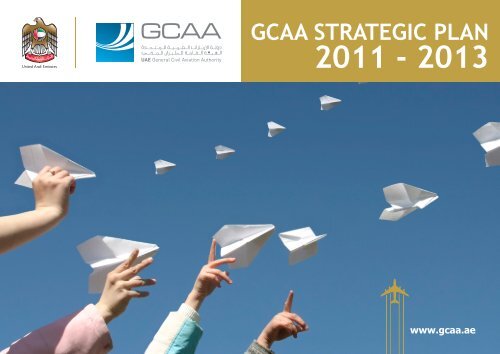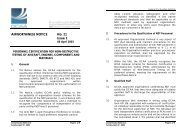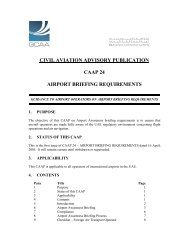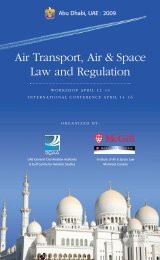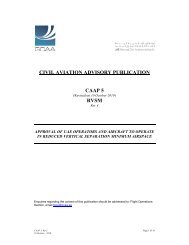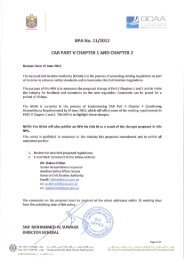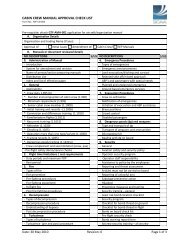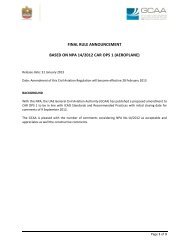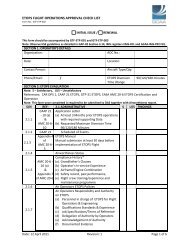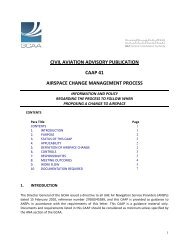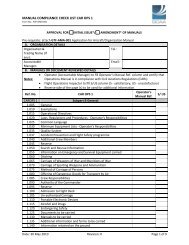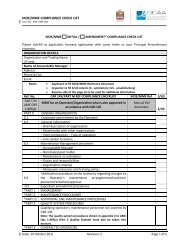GCAA STRATEGIC PLAN
GCAA STRATEGIC PLAN
GCAA STRATEGIC PLAN
Create successful ePaper yourself
Turn your PDF publications into a flip-book with our unique Google optimized e-Paper software.
<strong>GCAA</strong> <strong>STRATEGIC</strong> <strong>PLAN</strong><br />
2011 - 2013
Contents
Message from the Chairman 4<br />
Message from the Director General 6<br />
Forward 8<br />
<strong>GCAA</strong> Achievements 10<br />
Overview of UAE Aviation Sector 13<br />
UAE Macroeconomic and Aviation Sector Overview 14<br />
Globalization and Its Impact on UAE Aviation Sector 19<br />
Global Financial Crisis 20<br />
Aviation Safety and Security 20<br />
Challenges 21<br />
State Safety Program 22<br />
Air Space Capacity 22<br />
Air Transport Bilateral Agreement 23<br />
Environment 23<br />
New Technologies 23<br />
Staffing and Skill Gap Issues 24<br />
Budgetary Constraints 24<br />
Strategy Development 25<br />
Strategic Planning Process 26<br />
UAE Government Strategic Priorities and Initiatives 27<br />
Stakeholder Expectations 28<br />
Benchmarking 28<br />
SWOT Analysis 30<br />
Vision 31<br />
Mission 32<br />
Values 33<br />
Strategic Objectives 34<br />
Objective 1 34<br />
Objective 2 34<br />
Objective 3 35<br />
Objective 4 35<br />
Objective 5 36<br />
Objective 6 36<br />
Objective 7 37<br />
Objective 8 37<br />
Par Excellence 40<br />
Way Forward 42
Message from the<br />
Chairman<br />
The General Civil Aviation Authority’s (<strong>GCAA</strong>) fundamental<br />
mission is to lead the UAE Civil Aviation Sector by<br />
establishing and developing the policies and rules related<br />
to the regulation of air navigational services; raising<br />
safety and security standards. This industry plays a<br />
vital role in the economy and society through tourism,<br />
manufacturing and servicing. In upholding this mission,<br />
the Authority has focused on the future of the industry<br />
at large when deciding how best to promote the national<br />
carriers and has encouraged a healthy competitive environment<br />
of improved standards of safety, security and<br />
services. At a time when major airlines are struggling<br />
with decreasing load factors and increasing costs, the<br />
UAE carriers are expanding their fleets, hiring staff and<br />
increasing flight frequencies.<br />
While many of the legacy carriers are pushed into bankruptcy<br />
and cost-cutting initiatives, such as lay-offs, capacity<br />
reduction and cancelling plane deliveries, the UAE<br />
airlines are placing huge orders and looking for new<br />
markets.<br />
I believe that the keys to success in this highly competitive<br />
environment are technological innovation and<br />
management reforms. We are leveraging the combined<br />
strength of the UAE aviation sector without favoring or<br />
disfavoring any carrier. Together we will develop innovations<br />
aimed at taking the initiative in key areas such<br />
as next- generation technology, environmental sustainability<br />
and the highest standards of safety, security and<br />
services. This will be our winning formula.<br />
Eng. Sultan Bin Saeed Al Mansoori<br />
Minister of Economy Chairman of the <strong>GCAA</strong> Board<br />
4
Message from the<br />
Director General<br />
I am pleased to present the 2011–2013 Strategic Plan<br />
for the UAE General Civil Aviation Authority (<strong>GCAA</strong>). This<br />
strategic plan includes the Authority’s Vision for the next<br />
three years, its updated Mission Statement, Strategic<br />
Objectives and associated performance measures for<br />
managing the Authority’s operations.<br />
<strong>GCAA</strong> has been in the forefront of aviation safety and security<br />
issues, gaining valuable accident investigation experience<br />
and making considerable progress in the area<br />
of Air Navigation Services. Now, with this Strategic Plan<br />
and the process undertaken by the Authority to develop<br />
it, <strong>GCAA</strong> intends to be in the forefront of best business<br />
practices for long-term planning.<br />
Over the next three years, we will not only continue focusing<br />
on safety, security and the services we provide,<br />
but also improve the internal management of operations<br />
and staff.<br />
<strong>GCAA</strong> plans to integrate risk management systems and<br />
business practices. Through this world-leading initiative,<br />
the aviation industry in the UAE stands to gain better<br />
safety performance with less regulatory intervention.<br />
These are important steps towards improving safety and<br />
enhancing the public’s confidence in the safety of the<br />
UAE aviation system.<br />
Eight Strategic Objectives have been included in this<br />
plan with outcome-based performance measures for<br />
each Objective. The Authority is using these indicators<br />
to instill a performance-based culture of transparency,<br />
accountability and measurability of the achievement of<br />
its outcomes, resulting in an improved gauge of success<br />
for the realization of overall Strategic Objectives.<br />
I hope you find this Strategic Plan provides a clear understanding<br />
of the <strong>GCAA</strong>, its mission, mandate, and the<br />
strategic planning process.<br />
Saif Mohammed Al Suwaidi<br />
Director General – UAE General Civil Aviation Authority<br />
6
7<br />
Forward
<strong>GCAA</strong>’s Strategic Plan was formulated from the outcomes<br />
of gap analysis in three main areas: Regulatory, Support<br />
and Operations. The 2007–2010 Strategic Plan was<br />
focused on developing internal capabilities through the<br />
enhancement of processes and systems. Looking ahead,<br />
<strong>GCAA</strong> is determined to build on its past achievements<br />
and aims to create an environment that enables the entire<br />
civil aviation system to make world-class progress<br />
in the areas of safety, security and environmental sustainability.<br />
More specifically, <strong>GCAA</strong> has set its sights on<br />
becoming a globally recognized leader in civil aviation.<br />
This Strategic Plan has been developed to articulate<br />
<strong>GCAA</strong>’s direction from 2011 to 2013 and describes how<br />
<strong>GCAA</strong> will achieve desired results in line with the Strategic<br />
Priorities of the UAE. Appropriate Operational Plans<br />
have been drawn to disseminate the Strategic Objectives<br />
into action plans. However, due to the dynamic nature of<br />
this industry, changes and new challenges are expected.<br />
Therefore, these plans will be revised as necessary to<br />
reflect changing priorities and to achieve the most effective<br />
and efficient use of the <strong>GCAA</strong>’s resources.<br />
To meet future challenges, <strong>GCAA</strong> undertook an Overall<br />
Transformation Program (OTP). Some of the major<br />
achievements of this OTP include a new Strategic Plan, a<br />
Financial Plan, a new organizational structure and development<br />
of a Project Portfolio Management function. In<br />
recognition of its contribution to the International Civil<br />
Aviation Organization (ICAO), <strong>GCAA</strong> was overwhelmingly<br />
re-elected for the ICAO Council Seat in the 37th<br />
Assembly session in October 2010.<br />
Laila Ali Bin Hareb<br />
Director - Strategic Planning &<br />
Corporate Excellence<br />
8
9<br />
Our<br />
Acheivments
<strong>GCAA</strong> is proud to have embarked on the road to implementation<br />
of a State Safety Program (SSP). Once fully<br />
implemented, UAE will be among the very few countries<br />
to have established an SSP. The development and implementation<br />
of ROSI (Reporting of Safety Issues) and the<br />
automation of an oversight system through Q-pulse are<br />
two of the system enhancements achieved during the<br />
2007–2010 period. In order to support internal processes,<br />
the Enterprise Resource Planning system (ERP) has<br />
been successfully implemented. To ensure that <strong>GCAA</strong><br />
processes and procedures meet world- class standards,<br />
it has successfully achieved ISO 27001 and ISO 20000<br />
certification for its IT processes and has also started the<br />
journey to design, develop and implement an Integrated<br />
Management System (IMS) through the certification of<br />
ISO 14001 and ISO 18001, expected to be completed in<br />
2011. Internal process enhancements also include the<br />
completion of Administration, Procurement and Finance<br />
Authority matrixes and manuals.<br />
The <strong>GCAA</strong> has updated the specifications and requirements<br />
to obtain the Air Operator Certificate in line with<br />
the standards set by ICAO (Annex 6) thus becoming<br />
one of the first authorities to implement this initiative.<br />
The implementation of ROSI has resulted in 470 reports<br />
since the launch of this project in January 2010. <strong>GCAA</strong><br />
has also successfully implemented SAFA (Safety Audit of<br />
Foreign Airlines) and Q-Pulse in Flight Operations and<br />
Airworthiness.<br />
10
11<br />
Our<br />
Acheivments
<strong>GCAA</strong> carried out National Aviation Security Program for<br />
the industry. In order to enhance the standards and procedures<br />
for security of all cargo transported by air, <strong>GCAA</strong><br />
has developed and implemented National Screener Certification<br />
Program. <strong>GCAA</strong> also presented a draft amendment<br />
to the procedure for the transportation of dangerous<br />
goods by air, which was approved by ICAO and<br />
implemented by the states. In line with International Association<br />
of Air Transport (IATA) guidelines, <strong>GCAA</strong> carried<br />
out a study to improve the services and procedures<br />
for passengers with special needs or requiring medical<br />
attention.<br />
<strong>GCAA</strong> held many successful conferences and conventions<br />
in the area of safety and security. One of the prominent<br />
conferences was Aviation Security Conference, held in<br />
June 2010 and resulted in Joint Abu Dhabi Declaration.<br />
Search and Rescue Conference (SAR) was held in Abu<br />
Dhabi and attended by the President of the ICAO, council<br />
members and more than 250 delegates from around<br />
the world.<br />
Other system implementations or enhancements that<br />
were focused on improving <strong>GCAA</strong> services to its customers<br />
included full stand-alone Online Data Interchange<br />
(OLDI) capability and introduction of OLDI connections<br />
to major domestic airports and capable adjacent centers,<br />
introduction of Arrival Metering and Sequencing<br />
(AMAN) for UAE airports and an automated Aeronautical<br />
Information Management (AIM) system with electronic<br />
Aeronautical Information Publication (AIP) and Notice<br />
to Airmen (NOTAM) distribution and database. To improve<br />
communication standards with customers, <strong>GCAA</strong><br />
successfully implemented four communication channels,<br />
e.g. Twitter, Call Centre, and Interactive Voice Response<br />
(IVR).<br />
12
13<br />
Overview of<br />
UAE Aviation<br />
Sector
UAE Macroeconomic and Aviation Sector Overview<br />
While the Gulf Cooperation Council (GCC) makes up 9 percent of<br />
the total population of the Middle East and North African region, it<br />
captures 47 percent of the region’s GDP. Despite its small size, UAE<br />
is a major economic power within the GCC.<br />
GCC population has been increasing at 2 percent CAGR since 2000<br />
and is expected to reach the 47-million mark in 2020.<br />
1) MENA figures include Algeria, Tunisia, Sudan, Morocco, Mauritania, and Libya, and excludes Israel<br />
Source: Global Insights, July 2009 update; Booz & Company analysis<br />
GCC Geographic (1) and Economic Overview<br />
1779<br />
Total GCC Area= 2,574,942<br />
Syria<br />
Lebanon<br />
Iraq<br />
Jordan<br />
Iran<br />
Kuwait<br />
Egypt<br />
Bahrain Qatar<br />
Saudi<br />
Arabia<br />
UAE<br />
Oman<br />
2010 GDP<br />
Yemen<br />
- In 2005 USD Billions -<br />
MENA<br />
Km 2 47% of MENA GDP<br />
9% of MENA Population GCC 763<br />
2010 Population<br />
- In Millions -<br />
Saudi Arabia<br />
Booz & Company<br />
<strong>GCAA</strong>_selected_19h29.ppt<br />
0<br />
DATE<br />
415<br />
39.2<br />
Oman<br />
UAE<br />
Kuwait<br />
Qatar<br />
Bahrain<br />
Geographic Area<br />
2.1 M Km 2<br />
0.3 M<br />
Km 2<br />
83,600<br />
Km 2<br />
20,000<br />
Km 2<br />
11,437<br />
Km 2<br />
665<br />
Km 2<br />
29.9<br />
2% 2%<br />
8%<br />
7%<br />
11%<br />
69%<br />
2000<br />
34.6<br />
2% 3%<br />
8%<br />
8%<br />
12%<br />
68%<br />
2005<br />
GCC Region Population Trends<br />
- In Millions -<br />
(2000 - 2010F (1) )<br />
+2%<br />
39.2<br />
2%<br />
4%<br />
7%<br />
8%<br />
12%<br />
67%<br />
2010F<br />
1) Forecast developed by the United Nations Population Division<br />
Source: United Nationas Population Division, World Population Prospects, The 2008 Review; Booz & Company analysis<br />
43.2<br />
2%<br />
4%<br />
7%<br />
47.1<br />
2%<br />
4%<br />
7%<br />
Booz & Company<br />
<strong>GCAA</strong>_selected_19h29.ppt<br />
1<br />
DATE<br />
8%<br />
12%<br />
% of Expatriates in Population:<br />
GCC (including KSA): ~ 33%<br />
GCC (excluding KSA): ~ 60%<br />
KSA: ~ 20%<br />
67%<br />
2015F<br />
8%<br />
12%<br />
67%<br />
2020F<br />
Bahrain +2%<br />
Qatar +5%<br />
Oman +2%<br />
Kuwait +3%<br />
UAE +3%<br />
Saudi Arabia +2%<br />
14
Population growth is expected to maintain a healthy growth trend<br />
for GCC in general and UAE in particular. This is coupled with a 5<br />
percent annual GDP growth, which is expected to reach US$1.2 trillion<br />
in 2020.<br />
GCC population has been increasing at 2 percent CAGR since<br />
2000 and is expected to reach the 47-million mark in 2020.<br />
478 2%<br />
6%<br />
11%<br />
5%<br />
21%<br />
55%<br />
623<br />
5% 2%<br />
7%<br />
13%<br />
22%<br />
51%<br />
GCC Region GDP Trends<br />
- In 2005 USD Billion -<br />
(2000 - 2010F (1) )<br />
+5%<br />
763<br />
5% 2%<br />
9%<br />
12%<br />
23%<br />
48%<br />
955<br />
2%<br />
5%<br />
9%<br />
12%<br />
23%<br />
48%<br />
1,158<br />
2%<br />
5%<br />
9%<br />
12%<br />
23%<br />
49%<br />
Bahrain +5%<br />
Oman +5%<br />
Qatar +7%<br />
Kuwait +5%<br />
UAE +5%<br />
Saudi Arabia +4%<br />
500<br />
400<br />
300<br />
200<br />
Real GDP<br />
UAE Real GDP per Capita Evolution<br />
- Index Base 1980-<br />
(1980-2008)<br />
Population<br />
Real GDP Per Capita<br />
CAGR<br />
(1980-2008)<br />
6%<br />
5%<br />
Rank<br />
out of 205<br />
(2010)<br />
1<br />
3<br />
4<br />
5<br />
6<br />
7<br />
8<br />
11<br />
13<br />
25<br />
Liechtenstein<br />
Luxembourg<br />
Switzerland<br />
GDP per Capita in the UAE vs. Other Countries<br />
– in USD Thousands -<br />
(2010)<br />
0 40 80 120<br />
Norway<br />
Denmark<br />
Qatar<br />
Cayman Islands<br />
UAE<br />
USA<br />
Singapore<br />
2000<br />
2005<br />
2010F<br />
2015F<br />
2020F<br />
100<br />
-1%<br />
31<br />
54<br />
Kuwait<br />
KSA<br />
113<br />
China<br />
GDP/Capita<br />
- In Thousands -<br />
(2010)<br />
16.6 19.9 47.4 36.9 19.2<br />
56.8<br />
Saudi Arabia Oman UAE Kuwait Bahrain Qatar<br />
0<br />
1980 2008<br />
155<br />
India<br />
OECD ~ 35’<br />
GCC<br />
Source: Global Insights, July 2009 Update; Booz & Company analysis<br />
Booz & Company<br />
<strong>GCAA</strong>_selected_19h29.ppt<br />
2<br />
DATE<br />
Booz & Company<br />
<strong>GCAA</strong>_selected_19h29.ppt<br />
3<br />
DATE<br />
15
Figure 1: Real GDP Growth Evolution<br />
(Percentage Growth Rate 2010–2013)<br />
DP Growth Evolution<br />
Figure 2: Propensity for Air Travel<br />
Departing Passengers 2009 vs. Real<br />
GDP per Capita in US$ 2009)<br />
The UAE has witnessed 9 million tourist arrivals in<br />
2009, which is expected to grow at 7.2 percent per<br />
year in the next three years, particularly in the leisure<br />
market. The main driver for tourism is key landmark<br />
developments across the country.<br />
UAE Tourists Growth<br />
7%<br />
6%<br />
5%<br />
UAE<br />
MENA<br />
Trips per capita<br />
12<br />
11<br />
10<br />
Propensity for Air Travel<br />
Departing PAX 2009 vs. Real GDP per capita in USD 2009<br />
UAE<br />
Bermuda<br />
8.8<br />
25%<br />
9.0<br />
25%<br />
9.6<br />
24%<br />
7.2%<br />
10.2<br />
24%<br />
11.0<br />
25%<br />
11.9<br />
24%<br />
4%<br />
3%<br />
N. America<br />
2%<br />
Europe<br />
1%<br />
2010 2011 2012 2013<br />
9<br />
8<br />
7<br />
6<br />
5<br />
4<br />
3<br />
2<br />
1<br />
0<br />
Bahamas<br />
Macao<br />
Singapore<br />
Malta Hong Kong<br />
Bahrain Cyprus Ireland<br />
Qatar<br />
Maldives<br />
Belgium Denmark<br />
Switzerland<br />
Spain Barbados Austria Netherlands<br />
Oman<br />
Brunei<br />
Norway<br />
Italy<br />
Sweden Luxembourg<br />
Australia<br />
Saudi Arabia<br />
Kuwait US<br />
0<br />
10,000 20,000 30,000 40,000 50,000 70,000 80,000 90,000<br />
2009 Real GDP per capita (USD)<br />
75% 75%<br />
76%<br />
2008 2009 2010<br />
76%<br />
2011<br />
75%<br />
2012<br />
76%<br />
2013<br />
Booz & Company<br />
<strong>GCAA</strong>_selected_19h29.ppt<br />
Golden Horizon Charts.ppt Prepared for Etihad<br />
4<br />
DATE 6<br />
Booz & Company<br />
12 August 2010<br />
Golden Horizon Charts.ppt<br />
Prepared for Etihad<br />
16
Driven by economic growth, UAE airlines such as Emirates<br />
Airlines<br />
UAE<br />
have<br />
Fleet<br />
greatly expanded their network and<br />
fleet as shown in Figure 4.<br />
As a result, overall aircraft movements in the UAE are expected to grow to<br />
663,000 by 2013, including local and foreign airlines, general aviation, private<br />
operators and freighters.<br />
Figure 4: UAE Fleet Growth<br />
425<br />
Aircraft Movements<br />
118.5<br />
Figure 5: Aircraft 10.4% Movements (thousands)<br />
Figure 6: Air Crew Licensing<br />
16.2%<br />
270<br />
350<br />
481<br />
531<br />
+5%<br />
580 585 590<br />
620<br />
660<br />
165<br />
185<br />
Fleet Size<br />
53.7<br />
95<br />
2007 2008 2009 2010 2011 2012<br />
2013<br />
2004<br />
2006<br />
2008<br />
2010<br />
2012<br />
2014<br />
2008<br />
2016<br />
Booz & Company<br />
Golden Horizon Charts.ppt<br />
Prepared for Etihad<br />
7<br />
12 August 2010<br />
There has been a noticeable growth in the number of airline personnel<br />
Prepared for Etihad<br />
which has resulted in approximately 33% increase in the number of licenses<br />
issued by the Authority.<br />
Booz & Company<br />
Golden Horizon Charts.ppt<br />
5<br />
12 August 2010<br />
17
Middle East has the highest international and domestic growth<br />
of passenger traffic among other all regions. The international<br />
growth reached 10, and 10.3 for domestic growth.<br />
Figure 8: Regional passenger traffic overview<br />
(% change 2009 vs 2008)<br />
Table 7 Regional yearly traffic growth and market shares in<br />
percent (In terms of Passenger Kilometres Performed – PKPs)<br />
Passenger Traffic International Domestic Total<br />
Region Growth Market Share Growth Market Share Growth Market Share<br />
Africa -8.9 3 -13.4 1 -9.6 2<br />
Asia/Pacific -7.1 25 7.6 31 -1.2 27<br />
Europe -4 41 -10.5 8 -4.8 28<br />
Middle East 10 11 10.3 1 10 7<br />
North America -5.5 16 -5.5 54 -5.5 31<br />
Latin America -2.9 4 1.9 5 -0.7 5<br />
/Caribbean<br />
World -3.9 100 -1.8 100 -3.1 100<br />
North America<br />
• Traffic: -5.5%<br />
• Capacity: -6.1%<br />
• Load Factor:+0.5 PT<br />
Latin America<br />
• Traffic: -0.7%<br />
• Capacity: +0.4%<br />
• Load Factor:-0.8 PT<br />
Europe<br />
• Traffic: -4.8%<br />
• Capacity: -5.4%<br />
• Load Factor:+0.6 PT<br />
Middle East<br />
• Traffic: +10.0%<br />
• Capacity: +12.9%<br />
• Load Factor:-1.9 PT<br />
Africa<br />
• Traffic: -9.6%<br />
• Capacity: -6.4%<br />
• Load Factor:-2.4 PT<br />
Asia/Pacific<br />
• Traffic: -1.2%<br />
• Capacity: -1.2%<br />
• Load Factor:0 PT<br />
World 2009<br />
• Traffic: -3.1%<br />
• Capacity: -3.1%<br />
• Load Factor:0 PT<br />
Source: ICAO<br />
18
Globalization and its impact on UAE Aviation Sector<br />
To accommodate the airlines’ ambitious growth plans, airports<br />
have embarked on expansion plans to upgrade their infrastructure.<br />
UAE airports are investing up to US$50 billion in new and<br />
expanded projects over the next 15 years, which will provide capacity<br />
for an additional 200 million passengers per annum. A map<br />
of UAE airport locations is shown in Figure 7.<br />
Figure 3: UAE Airport<br />
Abu Dhabi Airport<br />
Dubai<br />
Airport<br />
Al Maktoum<br />
Airport<br />
Al Ain<br />
Airport<br />
Ajman<br />
Airport<br />
Sharjah<br />
Airport<br />
Ras Al<br />
Khaimah<br />
Airport<br />
Fujairah<br />
Airport<br />
Air travel remains a large and growing industry. It<br />
facilitates economic growth, world trade, international<br />
investment and tourism and is therefore central to the<br />
globalization trend worldwide. In the past decade, air<br />
travel has grown by 6 percent per year<br />
UAE airlines have taken full advantage of this trend<br />
through two relatively new airline models in the region.<br />
The first is the hub carriers, such as Emirates Airlines<br />
and Etihad Airways that have been developing their<br />
business model around the geo-centricity of the region<br />
and the 4 billion people that live within an eight-hour<br />
flying zone. The second model is the budget carriers,<br />
such as Air Arabia and Fly Dubai that have been taking<br />
advantage of the unprecedented boom in point-to-point<br />
travel within the region.<br />
United Arab Emirates<br />
Booz & Company<br />
Golden Horizon Charts.ppt<br />
Prepared for Etihad<br />
0<br />
12 August 2010<br />
19
Global Financial Crisis<br />
While most regions across the world have experienced<br />
slow growth in air travel over the past two years, the<br />
growth of the UAE aviation industry has been notable.<br />
During the economic crisis, continuous investments in<br />
aviation infrastructure and modern aircraft supported<br />
the continued expansion of the sector. The elements intrinsic<br />
to the market in the UAE that likely have led to<br />
this growth are:<br />
1. Business travel, given that the UAE economy is the<br />
business hub of the region<br />
2. Large population of expatriates, generating VFR traffic<br />
(Visiting Friends and Relatives)<br />
3. Religious traffic around Hajj and Umrah<br />
4. Labor traffic within the Arab world, and between the<br />
Gulf and Asia<br />
5. Low average age of the fleets, leading to somewhat<br />
lower operating costs<br />
Aviation Safety and Security<br />
Even though the UAE has an enviable aviation safety<br />
and security record, the country must continue to strive<br />
for the highest standards of safety and security. To satisfy<br />
the demands for improved standards of safety and<br />
tighter security, the regulatory bodies are working in<br />
conjunction with the aviation industry however, industry<br />
is driven by commercial interests. These economic pressures<br />
can affect all sectors of the civil aviation industry<br />
and could have an adverse impact on safety and security.<br />
It is, therefore, of crucial importance to the whole<br />
civil aviation community that the <strong>GCAA</strong> remains focused<br />
on aviation safety.<br />
Around the world, governments and airlines are regularly<br />
engaged in discussions on a wide range of significant<br />
regulatory issues addressing different aspects of airline<br />
operations, the largest being safety and security. However,<br />
approaches to managing these issues must be proactive<br />
rather than reactive. The focus to ensure sustainability<br />
must be directed on oversight and accountability.<br />
Without frequent and thorough auditing of the safety<br />
and security programs, even the best-laid plans can fail.<br />
6. Modern airport infrastructure encouraging hubbing<br />
operations between the East and the West<br />
20
21<br />
Challenges
State Safety Program<br />
The State Safety Program (SSP) is a relatively new concept and introducing<br />
this in the UAE presents challenges on all levels i.e. system,<br />
process, and people. <strong>GCAA</strong>, like any other civil aviation authority<br />
(CAA), supports its Safety Management Systems (SMS) through<br />
effective oversight activities, rulemaking and policy development.<br />
However, instead of reacting to the most recent accident, SSP rulemaking<br />
is based on the comprehensive analyses of the State’s aviation<br />
system. Regulations are based on identified hazards and analysis<br />
of the safety risks and related consequences.<br />
As part of the UAE SSP, the SMS requirements will be circulated<br />
to all service providers, requiring them to demonstrate their Safety<br />
Management capabilities up front, rather than waiting for accidents,<br />
incidents, or assessing non-compliance with safety standards. This<br />
will allow both <strong>GCAA</strong> and the service providers to proactively deal<br />
with safety risks.<br />
There are four components of the State Safety Program:<br />
1. State Safety Policy and Objectives: Development of a Safety Legislative<br />
Framework, Safety Responsibilities and Accountabilities, Accident and<br />
Incident Investigation and Enforcement Policy.<br />
2. State Safety Risk Management: Establishment of safety requirements<br />
for the service provider’s SMS and agreement on the service provider’s<br />
Safety Performance Standards.<br />
3. State Safety Assurance: Development of a Safety Assurance System<br />
that would consist of Safety Oversight activities, data collection, analysis,<br />
exchange and data-driven targeting of oversight of areas of greater concern<br />
or need.<br />
4. State Safety Promotion: Implementation of internal training programs,<br />
communication and dissemination of safety information and training to<br />
service providers.<br />
This is an enormous undertaking and a huge challenge, not only for<br />
the UAE <strong>GCAA</strong> but for every constituent of UAE Civil Aviation System.<br />
Air Space Capacity<br />
UAE Airspace<br />
(Commercial Corridors vs. Military Areas)<br />
UAE Airspace<br />
Restricted Areas<br />
The UAE has a total of 120,000 square<br />
kilometers of airspace, with 35 international<br />
air corridors. Today, more than 50<br />
percent of UAE airspace is comprised of<br />
aerial exclusion zones restricted to military<br />
use. To compensate for this shortage<br />
and the rapid growth of aircraft<br />
movements in the UAE airspace, the<br />
<strong>GCAA</strong> has heavily invested in adoption<br />
of new technologies to optimize use of<br />
available airspace capacity including:<br />
Booz & Company<br />
<strong>GCAA</strong> charts.ppt<br />
0<br />
12 August 2010<br />
• A state-of-the-art air traffic control center, the Sheikh Zayed<br />
Centre, was launched in 2009.<br />
• A new area navigation system, RNAV 1, was adopted.<br />
22
Air Transport Bilateral Agreement<br />
To date, the UAE has established 51 Open Skies agreements,<br />
through several opportunities for growth still remain.<br />
ral Agreements<br />
Environment<br />
The aviation industry has realized the importance of<br />
global environmental challenges and the need for direct<br />
actions. Aviation is responsible for about 2 percent of<br />
CO2 emissions, but it is widely accepted that the impact<br />
of aviation emissions is substantial.<br />
134 51<br />
38<br />
45<br />
In this context, the European Union (EU), followed by<br />
other states, is introducing an Emission Trade Scheme<br />
(ETS), which will be applicable to all airlines flying to,<br />
from, or within the EU. The ETS will have a substantial<br />
impact on the operations and financials of UAE airlines,<br />
particularly the new processes and tools that monitor<br />
carbon emissions. Additionally, there are ongoing discussions<br />
at the International Civil Aviation Organization<br />
(ICAO) and the Conference of the Parties (COP) of<br />
the United Nations Framework Convention on Climate<br />
Change (UNFCCC) to adopt an international framework<br />
applicable to aviation emissions. Accordingly, <strong>GCAA</strong> must<br />
gear up to actively participate in the ongoing discussions<br />
to implement and oversee the new policies.<br />
Total<br />
Open Sky<br />
Liberal<br />
Limited<br />
New Technologies<br />
Golden Horizon Charts.ppt Prepared for Etihad<br />
8<br />
Technological developments in the aviation industry pose<br />
a significant challenge in the achievement of our vision.<br />
Dramatic technological developments could outstrip our<br />
ability to train staff and redeploy resources. Among the<br />
developments we expect are increased use of composite<br />
23
materials to enhance fuel efficiencies, increasingly complex<br />
avionics and increased ultra long range operations<br />
(ETOP).<br />
As these and other technologies become widely used,<br />
<strong>GCAA</strong> staff will need to be fully engaged in learning<br />
about developments in these areas in order to effectively<br />
exercise their regulatory role and produce recommendations<br />
that continue to raise the bar on safety.<br />
Staffing and Skill Gaps Issues<br />
The Authority has been unable to meet its Emiratization<br />
targets for the last strategic planning period. This<br />
was primarily due to its requirements for staff to possess<br />
broad aviation industry knowledge in addition to investigative<br />
or related skills. Developing this diverse skill set<br />
takes years of experience. The Authority recruits staff<br />
from a talent pool consisting of three national carriers or<br />
from international sources. In either case, it is becoming<br />
increasingly difficult for the Authority to attract sufficient<br />
numbers of UAE nationals who posses adequate managerial<br />
and technical expertise to meet the ambitious<br />
Emiratization targets for this very exclusive industry.<br />
Inspectors, investigators and air traffic controllers are<br />
highly specialized and technical staff. The time needed to<br />
cultivate future leaders and technical expertise warrants<br />
serious attention to the development of human capital<br />
and succession planning to ensure continuity of leadership<br />
and availability of skill sets.<br />
Moreover, to function successfully, the existing workforce<br />
will require updated training to close the skill gap<br />
in a future environment that includes advanced management<br />
tools, new hardware and software platforms and<br />
updated rules and regulations. Aggressive training, development<br />
and recruitment initiatives will be necessary<br />
to attract highly skilled and diverse candidates to staff<br />
the growing needs of the Authority. Competency-based<br />
Job Description initiatives will allow us to identify a number<br />
of competency and skill gaps that would need to be<br />
closed through training and recruitment efforts.<br />
Budgetary Constraints<br />
Civil Aviation is a technology- and skill-intensive industry.<br />
To be in the forefront in a region that is home to some<br />
of the fastest growing and largest international carriers,<br />
<strong>GCAA</strong> must continuously invest in developing, upgrading<br />
or acquiring resources. At the same time, <strong>GCAA</strong> is committed<br />
to maintain its financial independence. Any major<br />
decrease in resources devoted to the <strong>GCAA</strong> will have a<br />
negative impact on its ability to achieve the strategic<br />
objectives for this planning period.<br />
24
25<br />
Strategy<br />
Development
Strategic Planning Process<br />
<strong>GCAA</strong> adopted a structured approach to define its Strategic Plan,<br />
starting with the definition of its vision and mission then describing<br />
the strategic imperatives and goals and how to achieve and track<br />
them.<br />
The Strategic Planning process kicked off with communication<br />
of the process to the different stakeholders, with<br />
an understanding of the Strategic Priorities of the UAE<br />
Government, a detailed baseline of the current situation,<br />
a stakeholders’ survey and a benchmark study.<br />
Planning<br />
horizon<br />
10-15 yrs<br />
3-5 yrs<br />
1-2 yrs<br />
What do we<br />
want to be?<br />
What will<br />
we do?<br />
How will<br />
we do it<br />
Steps<br />
Vision<br />
and Mission<br />
Development<br />
Strategic<br />
Imperatives<br />
Goal<br />
Setting<br />
Execution<br />
Planning<br />
Resource<br />
Allocation<br />
Questions Answered<br />
• What do we aspire to be?<br />
• Where do we want to go?<br />
• What are the “make or break”<br />
business issues?<br />
• What will we do to address these?<br />
• What are the specific targets that we<br />
need to fulfil in order to make our strategic<br />
imperatives happen?<br />
• What are the specific actions to reach<br />
these goals?<br />
• What are the deliverables and who is<br />
responsible?<br />
• What resources are required to achieve<br />
action plans?<br />
Based on the initial studies and through a series of workshops<br />
with <strong>GCAA</strong>’s senior executives, vision, mission and<br />
value statements were drafted by the Strategy and International<br />
Affairs Department and then approved by<br />
the Board of Directors.<br />
<strong>GCAA</strong>’s Directors, with the support of the Strategic Planning<br />
team, conducted a SWOT analysis and identified<br />
key strategic objectives, targets and initiatives to be implemented<br />
in the 2011–2013 period. For each initiative,<br />
a set of KPIs were defined to monitor the execution of<br />
the 2011–2013 Strategic Plan.<br />
monthly<br />
How will<br />
we track it<br />
Performance<br />
Measurement<br />
• What will we measure to track progress ?<br />
• What are the target results for each measure?<br />
React<br />
Management<br />
Reporting<br />
• What should be reported, how often and<br />
to whom?<br />
26
UAE Government Strategic Priorities and Initiatives<br />
In 2010, the UAE Government defined its Vision for the fifth year and its<br />
strategic objectives.<br />
In a strong and safe union, knowledgeable and innovative Emiratis will<br />
cofidently build a competitive and resilient economy. They will thrive as a<br />
cohesive society bonded to its identity, and enjoy the highest standards of<br />
living within a nuturing and sustainable environment.<br />
7. Enhance transparency and accountable governance mechanisms<br />
throughout Federal Entities<br />
Seven Strategic Priorities, directly linked to the UAE<br />
Vision themes, and seven key enablers were defined for the<br />
2011-2013 planning cycle.<br />
UAE Vision 2021 would be achieved through a roadmap of four<br />
consecutive UAE Government Strategy cycles.<br />
Seven General Principles were defined for the 2011–2013 cycle,<br />
which will ensure an accountable, lean, innovative and forwardlooking<br />
government:<br />
1. Enhance the role of Federal Entities in devising effective<br />
regulations and integrated policies by successful planning<br />
and enforcement<br />
2. Enhance effective coordination and cooperation among<br />
Federal Entities and with Local Governments<br />
3. Focus on delivering high-quality, customer-centric and<br />
integrated government services<br />
4. Invest in human resource capabilities and develop leaders<br />
5. Promote efficient resource management within Federal<br />
Entities and leverage dynamic partnerships<br />
6. Pursue a culture of excellence through strategic thinking,<br />
continuous performance improvement, and superior results<br />
UAE VISION<br />
(VISION 2021 SUMMARY)<br />
1 2 3 4<br />
Ambitious<br />
and Confident<br />
Nation Grounded<br />
in its Heritage<br />
Cohesive Society<br />
and Preserved Identity<br />
Competent<br />
Human Capital<br />
Customer<br />
Centre Service<br />
A Strong Union<br />
Bonded by a<br />
Common Destiny<br />
Safe Public and Fair<br />
Judiciary<br />
Strong Global Standing<br />
Efficient<br />
Financial<br />
Management<br />
Good<br />
Institutional<br />
Governance<br />
A Competitive<br />
Economy Driven by<br />
Knowledgeable<br />
and Innovative Emiratis<br />
Competitive Knowledge<br />
Economy<br />
Dynamic<br />
Government<br />
Networks<br />
First-Rate Education System<br />
World-class Healthcare<br />
Sustainable Environment<br />
and Infrastructure<br />
Effective<br />
Legislative<br />
Process &<br />
Integrated Policy<br />
Making<br />
A Nurturing<br />
& Sustainable<br />
Environment<br />
for Quality<br />
Living<br />
Effective<br />
Government<br />
Communication<br />
The Vision and the strategic direction of the UAE Government were<br />
adopted by <strong>GCAA</strong>’s management as key guiding principles and objectives<br />
to draft the <strong>GCAA</strong>’s Strategic and Operational plans for the<br />
2011–2013 cycle.<br />
27
Stakeholder Expectations<br />
A stakeholder study was carried out to gain a broad understanding<br />
of the key industry requirements and key areas for improvements.<br />
The study captured the 2010–2013 development plans of<br />
the <strong>GCAA</strong>’s stakeholders and the expectations in terms of <strong>GCAA</strong>’s<br />
services, regulations and modus operandi. Through interviews<br />
and meetings, <strong>GCAA</strong> was able to build a better understanding of<br />
stakeholders’ concerns, issues and proposed solutions.<br />
The major areas of interest for the stakeholders included:<br />
• Development of the UAE aviation sector<br />
• UAE National Aviation Policy<br />
• UAE regulations and their alignment with best practices<br />
• Capacity improvement of the UAE air space<br />
• Systematic Risk and Economic Impact Assessment for new regulations<br />
• Consultation process for new regulations<br />
• Outsourcing some non-core activities to specialised technical or shared<br />
services companies in order to free capacity for key regulatory functions<br />
• Technical skills of <strong>GCAA</strong> staff<br />
• Customer Oriented Culture<br />
Benchmarking<br />
A benchmarking exercise was carried out to derive key lessons<br />
from countries with a mature civil aviation system. The benchmark<br />
exercise focused on the following areas:<br />
1. Institutional set-up and regulatory system: Understand the air transport<br />
institutional set-up and the regulatory framework.<br />
2. CAA governance: Understand the governance system of the National<br />
Aviation Authority and the roles and responsibilities of the Board and<br />
Executive Management<br />
3. Operating model and Organization: Understand the operating<br />
model, the organization structure and the manpower requirements<br />
4. Financial: Understand the financial policies and funding mechanisms<br />
for the regulatory and operational aviation entities<br />
28
Benchmarking<br />
The benchmark study resulted in a set of principles that guided<br />
the formulation of the <strong>GCAA</strong> Strategic Plan:<br />
• National Aviation Policies (including Safety, Security, Airspace, Air<br />
Transport, Economic, Environment and Consumer Protection) as a key<br />
reference for development of the civil aviation sector<br />
• Clear and simple legal system frameworks to ensure clarity of roles,<br />
responsibilities and authority<br />
• A proper regulatory framework that ensures that the CAA remains<br />
independent vis-à-vis other institutions and aviation operators, in effect<br />
freeing them to focus on their core regulatory responsibilities<br />
• Lean organizational structures with a clear focus on the safety and<br />
security regulatory functions<br />
• A structured consultation process with stakeholders supporting the<br />
regulatory functions<br />
• A funding strategy based on a variety of fees and charges compatible<br />
with the International Civil Aviation Organization’s principles of costrelatedness,<br />
non-discrimination and transparency to minimize the requirement<br />
of state subsidies to CAAs<br />
29
SWOT Analysis<br />
The SWOT analysis enabled the <strong>GCAA</strong>’s management to rationalize the results of the initial studies and consequently to derive key<br />
strategic priorities.<br />
Strengths<br />
• <strong>GCAA</strong> has established strong relationships with the international aviation<br />
community through its presence at ICAO and its support to emerging<br />
economies.<br />
• <strong>GCAA</strong> board and management have launched an Overall Transformation<br />
Program (OTP) to align its operations to best practices.<br />
• <strong>GCAA</strong> has invested in IT technologies to improve the efficiency of some<br />
enabling and regulatory processes.<br />
• Senior and highly qualified<br />
technical experts are available at the <strong>GCAA</strong> to support the transformation<br />
program.<br />
Weaknesses<br />
• Comprehensive National Aviation Policies are not mature.<br />
• Comprehensive safety, security, and risk oversight systems require<br />
constant updating to ensure they are relevant.<br />
• Some of the core regulatory and enabling processes could be more<br />
efficient and effective.<br />
• Some new regulatory activities and capabilities still need time to<br />
become fully effective.<br />
• <strong>GCAA</strong> has both regulatory and operational roles.<br />
• <strong>GCAA</strong> fee structure requires revision<br />
to ensure its future costs are covered.<br />
• Organizational structure and<br />
staffing levels require constant<br />
review to ensure they meet future industry growth.<br />
• UAE Middle East air traffic has been resilient to the global economic crisis.<br />
• Current federal laws are in the process of being updated to clarify the UAE<br />
institutional setup and <strong>GCAA</strong> mandate.<br />
• UAE airlines are well regarded in the global aviation industry.<br />
• Stakeholders are supportive of the Overall Transformation Program.<br />
• Industry can undertake some of the <strong>GCAA</strong> activities to reduce the<br />
manpower requirements at the <strong>GCAA</strong>.<br />
Opportunities<br />
• Changes to the Civil Aviation Law have been proposed but are yet to<br />
be ratified by the Cabinet.<br />
• UAE and <strong>GCAA</strong> are subjected to audits from international authorities;<br />
adverse reports can affect the UAE aviation system and its growth<br />
plans.<br />
• Stakeholders find the responsiveness and quality of the <strong>GCAA</strong> services<br />
inconsistent.<br />
• Uncompetitive wages, in some areas, decrease availability of highly<br />
qualified employees to the <strong>GCAA</strong>.<br />
• EU emission trading scheme is not balanced by UAE emission<br />
requirements.<br />
Threats<br />
30
Vision<br />
A leading, safe, secure and<br />
sustainable civil aviation system<br />
31
Mission<br />
To regulate and oversee aviation<br />
safety, security and environment;<br />
deliver air navigation services; and<br />
facilitate air connectivity through<br />
international collaboration in order<br />
to serve the general public and the<br />
civil aviation industry in a responsive<br />
and cost-effective manner<br />
32
Values<br />
Safety and Security:<br />
Promoting a culture of safety and security at the individual and<br />
corporate level.<br />
People:<br />
Developing people to the highest standards and level of expertise<br />
in technical and non-technical areas.<br />
Stakeholder Focus:<br />
Promoting healthy dialogue and partnership with stakeholders.<br />
Integrity:<br />
Applying the highest legal, ethical and moral standards to our<br />
work and with each other.<br />
Professionalism:<br />
Encouraging an atmosphere of mutual respect, responsiveness<br />
and teamwork with our stakeholder community, general public<br />
and with our colleagues.<br />
Efficiency:<br />
Committing to continuous improvement in operations and costs<br />
through responsible management.<br />
33
Strategic Objectives<br />
Objective 1 –<br />
Strategic Objective<br />
Description / Rationale<br />
Key Results<br />
To ensure safe and secure operations<br />
of the aviation industry in compliance<br />
with ICAO standards and best<br />
practices<br />
As UAE Aviation regulator, <strong>GCAA</strong>’s primary focus<br />
is on ensuring safe and secure operations of the<br />
aviation industry through a set of policies and<br />
regulations and an active oversight.<br />
Support the UAE Federal Government<br />
in drafting UAE Aviation Policies (Safety,<br />
Security, Airspace, Environmental, Air<br />
Transport, and Consumer Protection)<br />
Draft and Implement a Safety Management<br />
System, Risk Oversight Plan, and State Safety<br />
Plan<br />
Draft and Implement a Security Risk<br />
Oversight Plan<br />
Update Safety and Security regulations<br />
Implement a Safety and Security Promotion Plan<br />
Objective 2 –<br />
Strategic Objective<br />
Description / Rationale<br />
Key Results<br />
To facilitate global connectivity<br />
<strong>GCAA</strong> will support the UAE aviation<br />
industry in increasing the level of connectivity.<br />
Convert existing MoUs into Air Service<br />
Agreements<br />
Introduce new Air Transport regulations<br />
34
Strategic Objectives<br />
Objective 3 –<br />
Strategic Objective<br />
Description / Rationale<br />
Key Results<br />
To develop UAE aviation environmental<br />
regulations and influence global<br />
policies to balance the needs of<br />
all stakeholders and international<br />
commitment of environment<br />
sustainability<br />
<strong>GCAA</strong> is committed to addressing global<br />
environmental challenges by drafting new<br />
environmental regulations and plans and by<br />
playing an active role in influencing global<br />
policies.<br />
Draft and implement new<br />
environmental regulations<br />
Support the UAE Government to<br />
draft an Aviation Environmental Sustainability<br />
Plan<br />
Objective 4 –<br />
Strategic Objective<br />
Description / Rationale<br />
Key Results<br />
To provide support services<br />
in the civil aviation sector<br />
<strong>GCAA</strong> aims to improve the quality<br />
of the service currently provided to<br />
the aviation industry.<br />
Complete the Separation and Enhance Plan<br />
of the Air Accident Investigation unit<br />
Set up a training centre<br />
Enhance ANSP services<br />
35
Strategic Objectives<br />
Objective 5 –<br />
Strategic Objective<br />
Description / Rationale<br />
Key Results<br />
To position the UAE to be globally<br />
recognized as a major shaping<br />
force in aviation<br />
In line with the direction of the UAE<br />
Government, <strong>GCAA</strong> aims to play a leading<br />
role in shaping the global civil aviation sector<br />
by becoming a key member of regional and<br />
international committees and by cooperating<br />
with international institutions.<br />
Implement international cooperation<br />
initiatives<br />
Become a key member of regional and<br />
international committees<br />
Objective 6 –<br />
Strategic Objective<br />
Description / Rationale<br />
Key Results<br />
To strengthen the internal processes,<br />
develop capabilities, and instill a<br />
culture of excellence in line with the<br />
best practices and the growth of the<br />
aviation industry<br />
As a best-in-class aviation authority, <strong>GCAA</strong><br />
aims to deploy efficient and effective processes<br />
and to build a work environment able to attract<br />
and retain Emiratis.<br />
Achieve an high employee<br />
satisfaction rate<br />
Review and deploy internal processes<br />
Reduce the overall cost per employee<br />
Increase the number of Emiratis<br />
Adopt electronic services<br />
Improve the quality of external services<br />
36
Strategic Objectives<br />
Objective 7 –<br />
Strategic Objective<br />
Description / Rationale<br />
Key Results<br />
To be communicative and responsive<br />
with national and international<br />
stakeholders<br />
<strong>GCAA</strong> aims to be more communicative<br />
and responsive to the stakeholders’<br />
requirements and to have a systematic<br />
approach to monitor its performances<br />
Improve responsiveness in<br />
addressing complaints<br />
Increase stakeholder satisfaction<br />
with <strong>GCAA</strong> communication approach<br />
Objective 8 –<br />
Strategic Objective<br />
Description / Rationale<br />
Key Results<br />
To be financially self-sustainable<br />
<strong>GCAA</strong> aims to become a self-sustainable<br />
authority in line with the ICAO principles and<br />
UAE Federal Government direction.<br />
Design and Implement Activity-Based Costing<br />
to align cost of service to fees<br />
Reduce operational costs<br />
37
39<br />
Par<br />
Excellence
Already in 2010, <strong>GCAA</strong> has launched key initiatives to meet its strategic<br />
goals and achieve excellence:<br />
1. Drafting of the national aviation policies will be kicked off before<br />
the end of 2010. In line with the UAE Government’s objectives and<br />
civil aviation best practices, a structured process will be designed to<br />
engage all stakeholders in defining the UAE National Aviation Policies.<br />
Once the consultation process is completed, the policies will be<br />
submitted to the UAE Cabinet for approval and ratification.<br />
2. The Air Accidents Investigation Unit is expected to be separated<br />
from the <strong>GCAA</strong> in 2011. <strong>GCAA</strong> has already started the ring-fencing<br />
process of the Air Accident Investigation Unit in order to ensure independence<br />
from the regulatory activities, and a decree has already<br />
been prepared.<br />
3. ICAO members recognized the leading role UAE played in shaping<br />
the global and regional aviation sector and hence have decided<br />
to re-elect <strong>GCAA</strong> as a member of the ICAO Council in October 2010.<br />
4. In September 2010, <strong>GCAA</strong> kicked off the drafting of the State<br />
Safety Program.<br />
5. In October 2010, the new organizational structure of <strong>GCAA</strong> was<br />
finalized, approved and communicated to all <strong>GCAA</strong> staff. The new organization<br />
ensures accountability, efficiency and effective operations.<br />
The new structure shall be effective 1 January 2011.<br />
40
41<br />
Way<br />
Forward
Going forward, the Strategic Planning team will lead the execution<br />
and monitoring of the <strong>GCAA</strong> Strategic Plan. In collaboration with the<br />
department heads, the Strategy and Performance Management Unit<br />
will identify risks and interdependencies to facilitate the Operational<br />
Plan management processes.<br />
Through a rigorous performance management system, progress of<br />
all projects will be monitored to reconcile progress and performance<br />
review to identify trends and challenges. The Strategy and Performance<br />
Management Unit will measure and report KPIs by collecting,<br />
verifying, and reporting business unit KPIs.<br />
42


